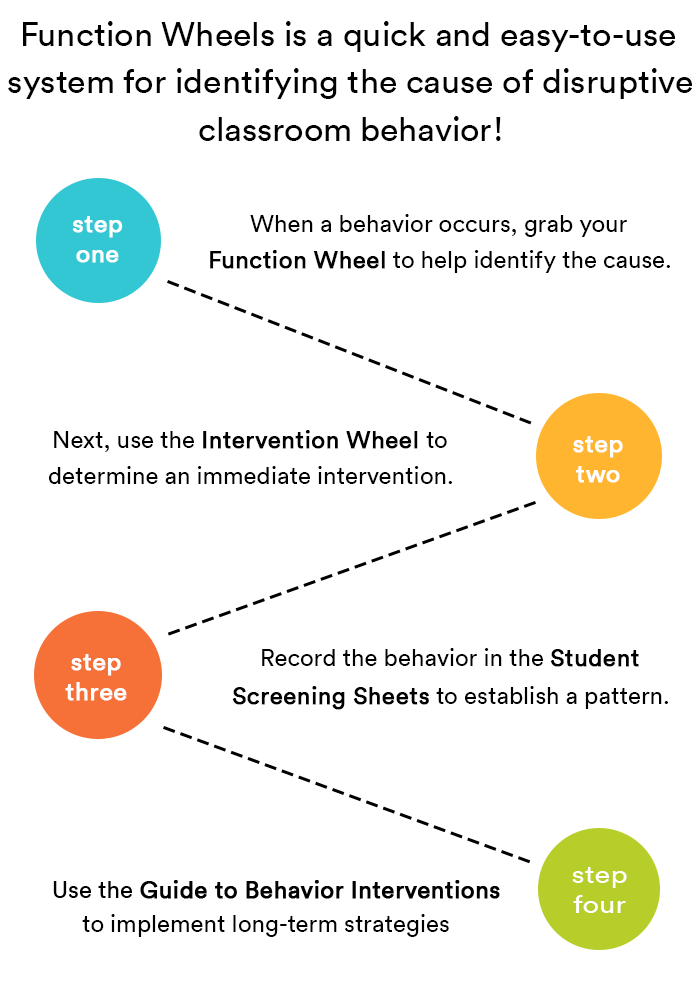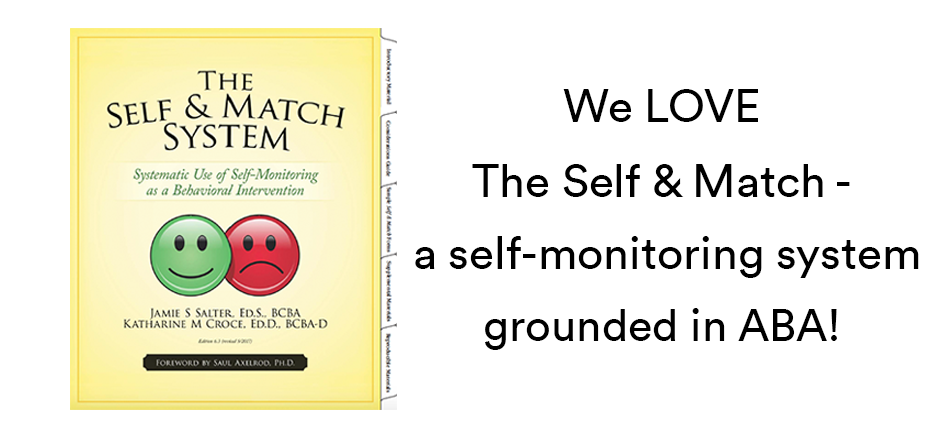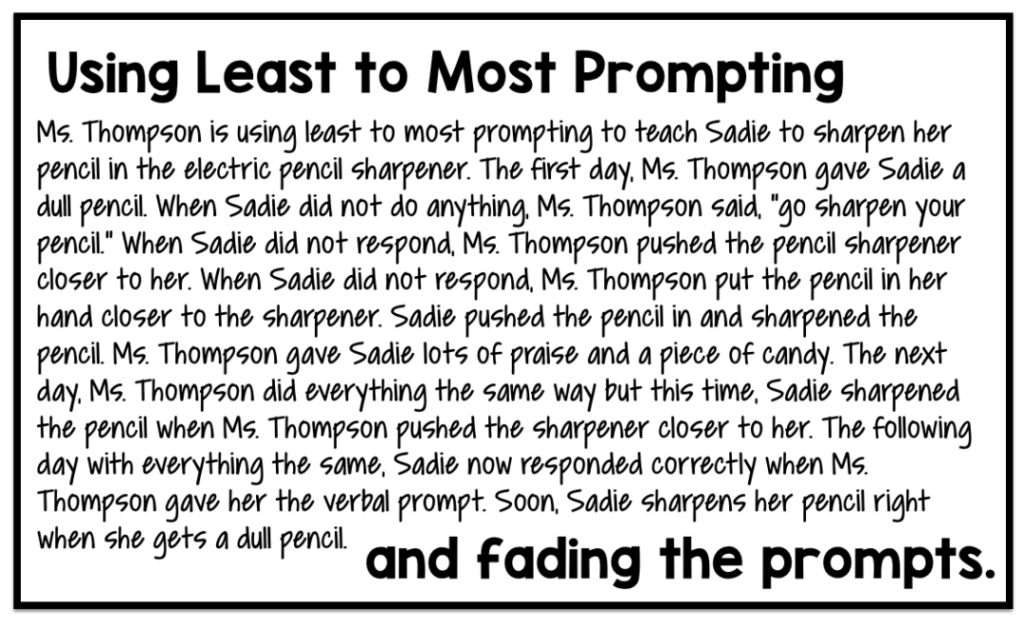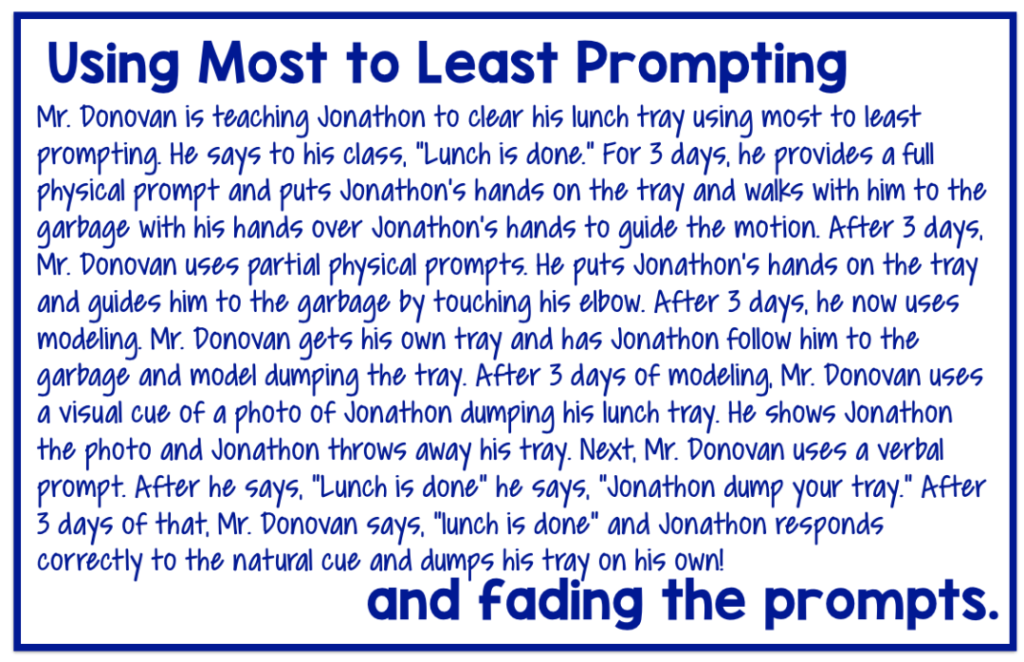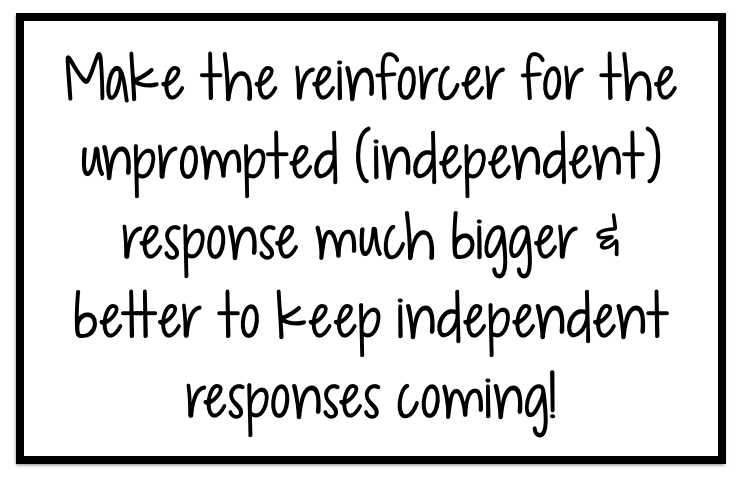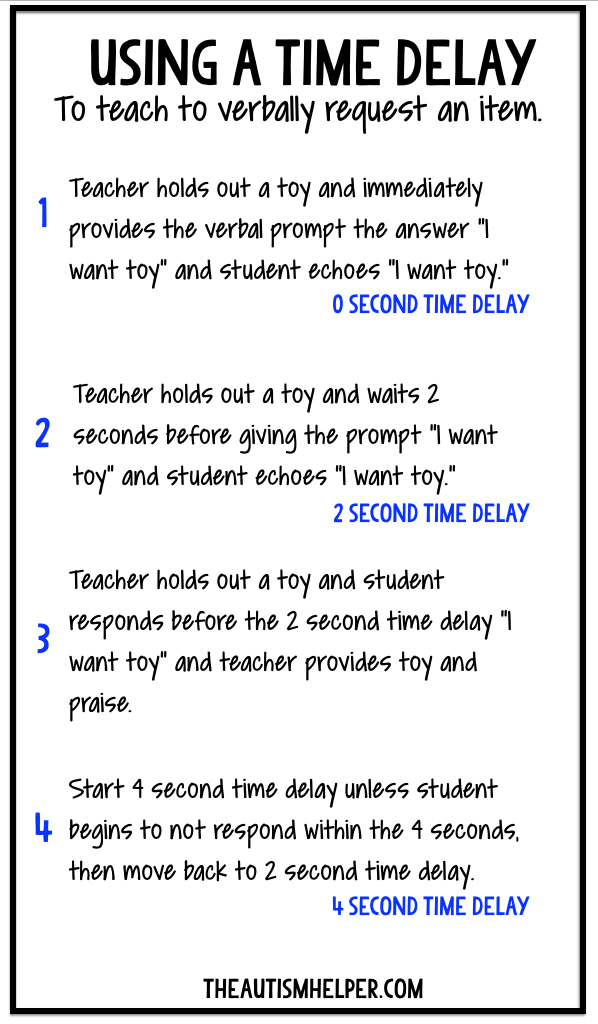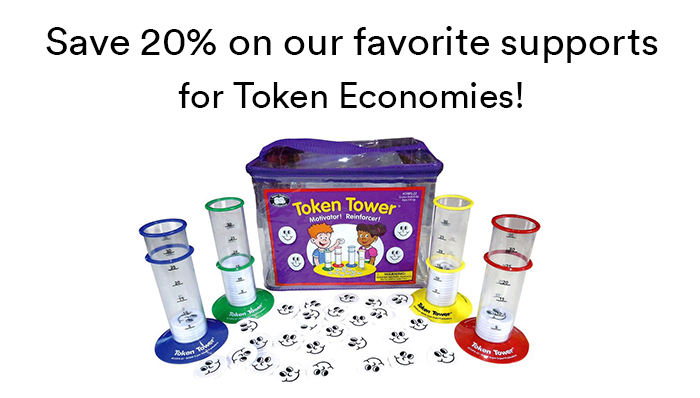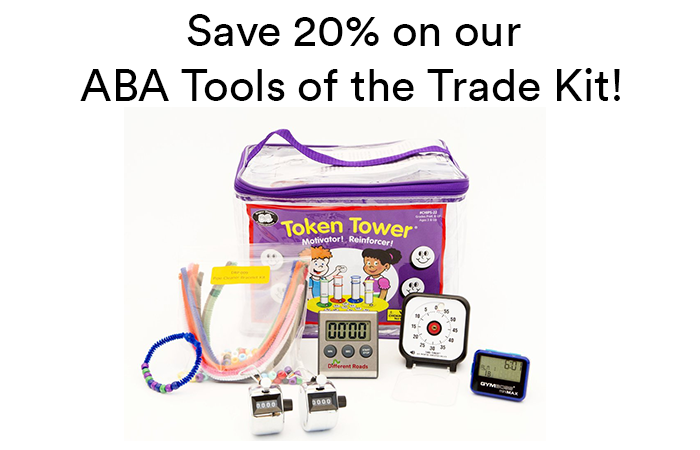Category Archives: Behavior
3 Ways To Fade Prompts
ABA Essentials Sale: Token Economies!
Qualifications of Practitioners/Consultants who Practice ABA
This month’s ASAT feature comes to us from Sabrina Freeman, PhD, ASAT’s Consumer Corner Coordinator. To learn more about ASAT, please visit their website at www.asatonline.org. You can also sign up for ASAT’s free newsletter, Science in Autism Treatment, and like them on Facebook!
It’s crucial to be a savvy consumer when it comes to one of the most important decisions you will make for your loved one with autism – choosing an ABA treatment provider for your child. Those of us who have already walked in your shoes know that all treatment providers are not the same. To the uninitiated, these professionals all look marvelous. From the slick websites, to the large numbers of associations of which these professionals are members, it is becoming increasingly difficult to differentiate between mediocre and outstanding treatment providers. Furthermore, publication of research in high quality journals is not synonymous with clinical expertise.
Fortunately, in this issue of Consumer Corner, we present a summary of consumer guidelines created by the Autism Special Interest Group (SIG) of the Association of Behavior Analysis International to help you make an informed choice when searching for ABA professionals to design, run and maintain your child’s program. A complete copy of the SIG guidelines are available here: https://3lvvdfmmeol12qpvw2c75ch6-wpengine.netdna-ssl.com/wp-content/uploads/2018/07/Final-Autism-Sig-Guidelines-Parent-Version-May-2018.pdf It is important to remember that your child’s future depends on highly quality consulting. Good luck!
- Certification:
Treatment professionals must all have advanced degrees, e.g., a Master’s Degree or a Doctorate in a relevant field of study, and be certified either by the Behavior Analyst Certification Board (BACB), or a board that has equal or higher level requirements than the BACB. To look up your consultant, visit: www.bacb.com and click on “Find A Certificant.” If the potential consultant is not on this list, ask where he/she became credentialed, and trained so that you can verify licensure and experience to determine whether it is equal to/or surpasses the standards of the BACB. If this individual responds to your inquiry in a defensive manner, then you may consider looking elsewhere as you are well within your right to seek clarification about certification status.
- Extensive Hands-On Supervised Training:
Consultants are required to have extensive hands-on training treating children with autism in which they have worked at least one full year (1500 clock independent supervised hours or 1000 hours if taking a university practicum and 750 hours if taking an intensive practicum) under the supervision of a credentialed BCBA Certificant. In addition, they need to prove competency in many areas that cover the design and implementation of both individualized ABA interventions, and comprehensive ABA treatment programs. The partial list below was created by the Autism Special Interest Group (SIG) below. Your consultant should be competent in all the following areas:
- a) Design and implement individualized ABA Interventions
- community living skills
- functional communication skills (vocal and non-vocal)
- “learning to learn” skills (e.g., looking, listening, following instructions, imitating)
- motor skills
- personal safety skills
- play and leisure skills
- pre-academic and academic skills
- reduction of behaviors that jeopardize health and safety and impede successful functioning (e.g., stereotypic, obsessive, ritualistic, aggressive, self-injurious, disruptive, and other behaviors often described as “challenging”).
- school readiness skills
- self-care skills
- self- management skills
- social interaction skills
- vocational
- b) Design and implement both comprehensive ABA intervention programs (using multiple ABA procedures to address multiple intervention targets) and focused interventions (using one or more ABA procedures to address a small number of intervention targets).
- c) Delivering ABA interventions directly to at least 8 individuals with autism who present with a range of repertoires, levels of functioning, and ages.
- d) Implementing the full range of scientifically validated behavior analytic procedures, including but not limited to:
- reinforcement (including differential reinforcement)
- extinction
- discrete-trial procedures
- modeling (including video modeling)
- incidental teaching and other “naturalistic” methods
- activity-embedded intervention
- task analysis
- chaining
- activity schedules
- scripts and script fading
- prompting and prompt-fading
- errorless training
- error correction
- motivating operations
- stimulus control
- preference assessments
- choice
- augmentative and alternative communication training procedures.
- Continuing Education:
Not only do behavioral consultants need to be trained as above, in order to maintain their certification, practitioners must also pursue continuing education in a variety of areas that may include, but are not limited to, Applied Behavior Analysis.
Red Flag
These practitioners should not be working collaboratively with professionals who implement an eclectic mix of interventions that are untested, discredited or experimental in nature. If the consultant you use endorses an eclectic approach, understand that this practice is inconsistent with the BACB Guidelines for Responsible Conduct for Behavior Analysis. This red flag is a particularly helpful way to be forewarned about a consultant who is not a good choice to design and maintain your child’s program!
Running behaviors? Tips for Making Your Class & School Safe
Running is a scary behavior and potentially dangerous behavior because your student could get outside of the school. He could get lost, hit by a car, or walk into a stranger’s home. If your child or student has these types of behaviors, your mind has definitely gone to these worst case scenarios. I remember losing sleep regularly thinking about a student who had high frequency running behavior and stressing like crazy over what would happen if he ever got out of the school.
Keep them in your class. This is really the golden rule when it comes to runners. Do whatever you can to keep them in your room. Once that foot gets one inch outside your door, all bets are off. Once they are outside your room, you are chasing them and they are loving it. You’ve completely reinforced the inappropriate behavior but you had no choice. You had to keep them safe. Some schools may have systems set up with different staff at different spots in the hallway or building so you can avoid that. But unfortunately many of our classrooms don’t have that much staff to do that. The number one goal is keeping them safe, so do whatever you have to do to get them once they leave your room. But the goal is avoiding that. The goal is keeping them in your room where you can be teaching replacement behaviors.
In the effort to keep them in your room, think obstacles. Go through your student’s schedule and make sure that at every single point of the day there is not a direct pathway to the door. When I do behavior consults, the teacher and I literally do this together. We walk around the room and go to every single spot the student will be at. Sometimes you forget about a specific center or time of day when the student is very close to the door. You classroom may look like a maze. That’s okay. That’s actually good. A maze means it will take your student 4 seconds instead of 2 seconds to get to the door and the extra 2 seconds may be enough to prevent that escape. Use furniture and dividers to create zig zag pathways around your room. I know it’s tempting to do something potentially unsafe like put a lock on the door – but it’s majorly breaking fire code so steer clear of that. If you have two doors in your room, block one up completely so you only have to worry about one.
Have a super clear and straightforward schedule of who is in charge of this student at all times of day. Make sure the transition handoff is clear. Clarify with staff what they should do if they need to go to the bathroom or get up to get a pencil when working with this student. Make sure the goal is clear to everyone – keep him in the room.
If they do get out – minimize the attention component. Sometimes we are doing everything right, working on analyzing the function of the behavior, teaching a replacement response, added in loads of preventative interventions keep the student in your classroom – and life happens and you blink and your student is halfway down the hallway. As we talked about, yes you are going to run after him to get him because above everything safety is important. But minimize the attention that goes into this. Picture two scenarios: 1 – Johnny runs down the hallway. Three adults start running after him, one of them yelling. They catch up to him. One adult yells to the other, “got him.” Another adult, starts lecturing Johnny on we he shouldn’t be running. The three adults walk him back together talking amongst themselves about how fast they are getting. They re-enter the classroom and announce to everyone in the room loudly, “he one got to the end of the hallway.” Basically it’s a circus. I see this ALL the time. And it’s unintentional. None of those adults wake up thinking let’s turn Johnny’s behaviors into a parade today, but it happens. We get scared, adrenaline is rushing, and we don’t have a clear plan in place. Let’s rework this scenario. Johnny runs. One adult makes eye contact with another adult in the classroom and says, “I’m on it.” One adult runs after him, another waits in the doorway of the classroom to watch. When the adult gets him, she says nothing and walks him back to the classroom. He goes back to the exact task he was doing before without any eye contact or talking/lecturing. Attention was minimal. Attention may be a function for many of these behaviors so even though we have to give attention by chasing we can minimize the magnitude of the attention.
Know where all the school exits are. Seems obvious but I worked in a school for ten years and honestly still didn’t know where all of the exits are. Really old buildings have a seemingly endless amount of hidden doors to the outside. I finally had the school engineer walk me around the basement so I could find them all. Once you know where the main exits are, you can divide and conquer with staff. If your student is running the direction of an exit, one staff member can run ahead to that door or go meet him where the door opens outside. #themoreyouknow
Have a plan with the security guards for the worst case scenario. You guys know I’m all about having an emergency plan in place and you likely already have one with your classroom staff (if you don’t – make one!). But take that emergency plan beyond just your classroom staff. Work with your school’s security guards to get them in the loop. If that horrible worst case scenario happens and your student does somehow get out of the building, what is the plan? We tend to avoid making a plan for this because we think it never will happen. Agreed, plan for it never happening. But just in case at the rare, rare, rare chance it does – you will be much better off with a plan in place.
Use Walkie Talkies with key people through the school. Walkie talkies can be your saving grace here. Many schools already have a system of walkie talkies in place and if you aren’t part of – get part of it. If you student has left the classroom, you will be much more efficient getting him back to the class if you can alert 8 people throughout the building of it versus doing it yourself. If you school doesn’t use walkie talkies, approach your admin about getting a set for your classroom staff and a few key people through the building (security guards, secretary, etc.).
This piece was originally posted at The Autism Helper.
About The Author
Sasha Long, BCBA, M.A., is the founder and president of The Autism Helper, Inc. She is a board certified behavior analyst and certified special education teacher. After ten years of teaching in a self-contained special education classroom, Sasha now works full time as a consultant, writer, and behavior analyst. Sasha manages and writes The Autism Helper Blog, as a way to share easy to use and ready to implement strategies and ideas. Sasha also travels internationally as a speaker and consultant providing individualized training and feedback to parents, educators, therapists and administrators in the world of autism. She is currently an adjunct professor in the school of Applied Behavior Analysis at The Chicago School of Professional Psychology. Sasha received her undergraduate degree in Special Education from Miami University and has a Masters Degree in Applied Behavior Analysis from The Chicago School of Professional Psychology. Contact Sasha at sasha.theautismhelper@gmail.com.
Managing a Home-Based ABA Program
This month’s ASAT feature comes to us from Beverley Sharpe, a founding member and Director of Families for Early Autism Treatment of B.C. To learn more about ASAT, please visit their website at www.asatonline.org. You can also sign up for ASAT’s free newsletter, Science in Autism Treatment, and like them on Facebook!
We have a home-based intervention ABA program for our son. What are some helpful suggestions for managing the steady stream of professionals in our home?
Answered by Beverley Sharpe, parent of a 22- year-old daughter with autism
Opening your home to therapists, behavioral consultants, and other providers is part of effective treatment for your child. However, it can sometimes be difficult to supervise a home that doubles as a work environment and the many opportunities and challenges that come with that arrangement. I am humbled by the high level of energy and dedication my therapy teams, past and present, have demonstrated within my own child’s program. Teamwork and collaboration are crucial elements to make home therapy effective. The following are some helpful tips I’ve learned over the years to help make home team coordination more manageable.
Be a Good Host/Hostess
I have struggled at times to balance being a “boss” and a “hostess” within my home. At the start of a shift, I recommend a five-minute exchange to greet and debrief the provider. No matter what job one has, people deserve to be acknowledged and greeted. I typically put on the tea pot or provide a cold drink, say hello, debrief, then let the provider begin the shift. With a new provider, I allow more time for him or her to set up materials, reinforcers, and data sheets before bringing in my child.
Define Your Expectations of Those Who Work with Your Child
An agency that provides home-based intervention will have a written job description or list of expectations for employees. If you are not working with an agency but are, instead, hiring and training your own team, please take the time to put important expectations in writing. Being on time, completing data sheets, communicating about behaviors observed, being prepared for shifts (including bringing appropriate task and reinforcer materials), and respecting other family members are examples of appropriate expectations.
Get Feedback from Staff
Over time I learned to explain to the team that it is hard for me to be both a boss and a friend. I truly did want to be a good listener, and at the same time a good manager of the team. I enjoyed the one-on-one time at the beginning of a shift with each provider and would ask, “How are you?” and “How are you finding the work with my child?” Their answers inspired me to make changes to the program, address issues with the behavioral consultant, and work on team building during team meetings that became more frequent when my daughter’s inappropriate behaviors became challenging.
When conflicts of any kind arise, talk about it and clear the air so that tensions or misunderstandings do not fester. Speaking about problems factually, face-to-face, with a hot cup of tea or coffee is a strategy that I have used. Also, I would make sure my daughter was engaged in an activity before starting the conversation. Remember, you can control yourself, your communication style, and the environment when you address an issue. Being respectful, honest and kind are great ways to be sure you have done your best to address issues. In my experience, new directions have come from allowing members of the team to share their perspective with you. Your child’s quality of life depends on effective intervention, and a home that is warm and inviting to the hard working providers who share your vision will help your son realize his fullest potential.
Keep in Touch with Former Providers
Email has enabled me to keep in touch with some of the former providers who have worked so hard with my child. One of Allison’s former providers is now professionally trained in hairdressing. Every year before Christmas this provider comes to our home to gift Allison a Christmas haircut! I love the expression, “Friends are like stars, you can’t always see them, but you know they are there.” I think of all past and present providers as being Allison’s stars, not all providers will maintain relationships with the family. The reality of employing people in your home is that some will choose, for reasons of their own, not to stay in touch with you or your child. Don’t take it personally. Life happens to everyone! Also, keep in mind that agencies may have policies forbidding contact outside of the current professional relationship.
Acknowledge Other Siblings in the Household
Shortly after putting together my first therapy team in 1997, I realized I had to address the issue of acknowledging siblings in the household. My daughter, Allison, who was receiving services in the home, was 3 years old at the time. She had a big brother, Jackson, who was 5 years old. Jackson came to think of it as normal that he would have to move from one room to another when Allison’s therapy sessions were in progress. He was always good-natured about this. I wanted to keep big brother Jackson involved with sessions, as appropriate, to help him feel more involved, instead of just frequently displaced. For example, turn-taking was a wonderful way to involve Jackson, as was the “Go Find” program.
I also reminded providers to acknowledge Allison’s brother whenever possible. I reminded them that a simple and genuine greeting will go a long way with his cooperation in the house! This helped to make Jackson’s cooperation more likely when he was asked to move to another room during a therapy session. Also, Jackson was taught to ask a provider, “What can I do to help my sister today?” when a provider started her shift. This simple act facilitated Jackson’s knowledge of his sister’s abilities, and gave him a lot of pride when he was able to tell his friends that he was helping his sister to learn! Big brother Jackson then became a big help during sessions by moving and sharing his play toys, games and puzzles and allowing space for his sister and her therapy team. Always remember, siblings are part of the household that supports the learning of the child!
Recognize That Housekeeping Is Important
Remember, your home is a provider’s work environment. I do my best to clean and tidy the therapy area before tackling any other room in the house on cleaning days. I also do a quick check of the bathroom area before sessions, as everyone appreciates a clean washroom! I make sure therapy notes, bulletins, communiqués are all neatly on their clipboards. I also make sure that my child is clean and presentable for the shift. Finally, I make sure that there is an “outing fund” with money for community activities. If my child worked towards a reward of an outing to the zoo, Dollar Store, or movie theatre, I wouldn’t want the lack of funds to delay the delivery of that reinforcer. Make sure your team knows to keep receipts for outings which are approved by the behavioral consultant and yourself. Also, remember to reimburse bus fare or gas money for a provider. Agencies will likely already have a policy in place for travel expenses as well.
Be a Good Employer, Which Means Advocating for Your Staff
Therapy time does not equate to babysitting. I had to correct a few well-intentioned neighbors who referred to my providers as babysitters. When my child is in the community, grocery shopping, at a gymnasium, or at work experience, these hardworking men and women are providing therapy, not just watching or transporting my child. Providers are important members of your child’s medically necessary treatment team. Correct misconceptions by family and friends along the way. Many family and friends may not be familiar with this type of therapy or treatment and may need some educating about the purpose and format of a home-based intervention based on applied behavior analysis. This education can help preserve the dignity and respect of your child, your team, and the discipline of applied behavior analysis for autism.
Stay in the Home During Therapy Time
For insurance purposes, many agencies require that a provider not be left alone in your home. Providers work in your home and deserve a safe and respectful environment. This means that a parent must remain in the home during a therapy session. This can be helpful for routine questions and support as well as in case of any emergencies.
Set Clear Expectations Around Cell Phone Use
The abundance of cell phones means that providers and families can be in real-time communication for shift or program issues relating to the child. However, they can also be a distraction from active treatment and supervision of my child. This has occasioned another hiring criteria for being on my child’s treatment team: Cell phone use for anything other than communication about the child, on their shift, is not acceptable. Cell phone games, texting, social media, and other social messaging are not acceptable. Even the ten seconds (as stated by one provider) it takes to text back to a friend means you are disengaged, not observing, and not “on” with your client – my child. Cell phone use expectations must be made clear from the very beginning and reiterated as needed.
Gift Giving
Holiday time was always a tough time at my home. In British Columbia, there was zero funding for autism treatment when I started my daughter’s program in 1997. I wanted to give tokens of appreciation to my daughter’s home treatment team for the holiday season. My budget was beyond tight, but homemade cards were always appreciated. One family I knew put together a cookbook of favorite home recipes for their home team; another family made a huge holiday dinner, in conjunction with a team meeting, to thank their team. There is always a way to say thank you to your team that is respectful of one’s budget.
Please note that many agencies and ethical guidelines for behavior analysts have strict policies around gift exchange and it is often not permitted. Check with your agency and your providers if you have any questions around this topic. And please do not be offended if a member of your team is not able to accept a gift.
Use Different Cultures and Celebrations as Learning Opportunities
We took the opportunity to learn about different religious holidays when one of our providers shared that she was Jewish. This was a wonderful learning opportunity for everyone on the team. We even made a card for the start of the Jewish New Year – Rosh Hashanah. Over the years, my daughter’s providers brought the wonderful gifts of sharing their religious holidays, culture, and favorite recipes that have enhanced our lives!
Making birthday cards for therapy team members gave my child the opportunity to use pencil and coloring skills, printing skills, and to sing the “Happy Birthday” song. All of these skills took a long time for acquisition. However, after all the hard work, to see my daughter use her skills to put a smile on her providers’ faces was priceless. To hear my child use her voice (she was non-verbal for the first 6 years of her life), and to hear her sing Happy Birthday – well, it is a win-win situation!
With a therapy team, it is a wonderful opportunity to have a simple celebration for each of the several birthdays throughout the year. My child learned that birthdays are for others as well as for herself. This learning extended to teaching big brother Jackson that every time we celebrate a birthday, he does not always get a present!
As our programs progressed, our behavior consultant added a cooking and baking program to help include both children in all household birthday celebrations for family members and members of the treatment team. The beauty of a cooking program was that skills, such as: counting, measuring, mixing, pouring, baking, decorating with icing, and washing and putting away dishes, were all “taught” in a fun way. This was a very detailed program with the huge reinforcer of getting a tasty item to eat at the end of completing a recipe!
In Summary
Managing an ABA treatment team in your home can be challenging but can be rewarding as well. There are many things you can do to help the team work well together and be effective in providing your child with the services he or she needs and deserves. Remember, it’s a learning process for all!
Please use the following format to cite this article:
Sharpe, B. (2017). Clinical corner: Managing a home-based ABA program. Science in Autism Treatment, 14(3), 17-20.
About The Author
Beverley Sharpe is a founding member and Director of Families for Early Autism Treatment of B.C. (FEATBC). Bev’s daughter Allison was diagnosed with autism twenty years ago and Bev became an advocate for effective autism treatment. She was a member of the Legal Steering committee for the Canadian landmark decisions (Auton and Hewko) regarding autism treatment. Bev participates in new parent intake, political lobbying, fundraising, and speaks regularly with parents regarding advocacy in the school system. She also helps new parents access funding for autism treatment.
The ABA Tools Of The Trade Kit!
While data collection is a cornerstone of ABA, and essential for providing effective interventions, there are many obstacles to collecting accurate data. My colleague Val Demiri and I have focused a lot of time and attention to addressing these obstacles and working to make the data collection process easier.
The new ABA Tools of the Trade Kit includes some of our most-used tools, from low-tech tools such as the abacus bracelet to high-tech such as the GymBoss. The tools included here allow you to take a variety of types of data. Here’s a peek at what’s inside:
Tally counters: This is one of the simplest tools available, but incredibly useful. Put it on a lanyard around your neck or keep it in hands-reach to easily tally the number of instances of a target behavior.
Time Timer: I use this tool all the time with my clients. It provides a great visual for them to see time as it is elapsing. I use it for teaching children to wait for a preferred item/activity and to remain on task while the “red bar” is showing.
GymBoss: This interval timer is one of my favorite and most-used tools. I’ve used it and similar items in a variety of ways, for helping parents and teachers provide more positive reinforcement, teaching clients self-management skills, and keeping track of interval schedules of reinforcement when I’m implementing an intervention.
Audible Timer: While this is a basic tool, having something with an auditory stimulus is invaluable!
Token Tower: Speaking of auditory stimuli, this is one of my favorite token systems simply because the plastic token makes a sound when it drops into the tower. I also love that I can move the ring up and down the tower to indicate how many tokens the client must earn.
Abacus Bracelet: This is one of the best low-tech tools around. It’s especially great for classroom teachers who are trying to count a target behavior while teaching. Simply move a bead from one side of the bracelet to the other, and then at the end of the lesson count how many beads were moved. I love technology, but sometimes you can’t beat simplicity.
ABA Tools of the Trade: The book is also included in the kit, which provides much more information about these and other tools, as well as dozens of examples of real-life scenarios.
WRITTEN BY SAM BLANCO, PhD, LBA, BCBA
Sam is an ABA provider for students ages 3-15 in NYC. Working in education for twelve years with students with Autism Spectrum Disorders and other developmental delays, Sam utilizes strategies for achieving a multitude of academic, behavior, and social goals. She is also an assistant professor in the ABA program at The Sage Colleges.
How to Avoid Over-Pathologizing Behaviors in Kids with Autism
A diagnosis of autism can be very challenging for a child and for his or her family. But one of the most difficult aspects of autism is that it is not clear cut what behaviors are related to autism, and what behaviors are related to just being a kid. Every child tantrums sometimes. Every child talks back sometimes. Every child engages in dangerous behavior sometimes.
When I look back on my own childhood, I think of several behaviors I exhibited: in third grade I cut my own hair while my teacher’s back was turned, in fourth grade I got mad at my brother and threw an alarm clock at him, and in seventh grade I loved Agatha Christie books so much that I frequently refused to go outside and sat in my room reading by myself for hours on end. If I had autism, any one of these behaviors may have been pathologized instead of being considered as just a part of growing up.
So how do you parse through all the behaviors your learner is exhibiting and figure out which ones you should actually be worried about? Here are a few questions to ask yourself in determining behaviors to address:
- Is the behavior dangerous?
- How often and for how long does your learner engage in the behavior?
- How different is this behavior from the learner’s same-age peers? For example, does your three year old cry for a couple minutes when told that she can’t have her favorite toy, or does she cry for two hours and refuse to engage with any other toys for the rest of the day?
- How is this behavior interfering with the learner’s ability to learn?
- How is this behavior interfering with the learner’s ability to engage with peers and family members?
- Is the behavior related to a skill? For example, pacing the room and flapping your arms is typically not related to a skill, but building Lego models can be related to a skill. If it is related to a skill, think about ways to provide opportunities for expanding that skill.
The answers to these questions should be able to inform the decisions that you make in intervening with behaviors. And we should remember that above all else, kids with autism are still just kids.
WRITTEN BY SAM BLANCO, PhD, LBA, BCBA
Sam is an ABA provider for students ages 3-15 in NYC. Working in education for twelve years with students with Autism Spectrum Disorders and other developmental delays, Sam utilizes strategies for achieving a multitude of academic, behavior, and social goals. She is also an assistant professor in the ABA program at The Sage Colleges.
The Function Wheels
This month’s ASAT feature is a review of the Function Wheels, one of our Different Roads exclusives! To learn more about ASAT, please visit their website at www.asatonline.org. You can also sign up for ASAT’s free newsletter, Science in Autism Treatment, and like them on Facebook!
Reviewed by
Jen Cote, BA, Extern
David Celiberti, PhD, BCBA-D
Association for Science in Autism Treatment
Individuals with autism often demonstrate challenging behaviors in home, school, and community settings and, as a result, their service providers develop behavioral interventions to address these challenges. The effectiveness of behavioral interventions is predicated, in part, consistency across people and settings. Aside from inconsistent implementation, one of the primary reasons for the failure of interventions targeting the reduction of challenging behavior is that the intervention does not adequately address the underlying function of the behavior. Behavior intervention plans can be conceptualized in one of three ways:
- Functionally relevant in which the intervention reflects the underlying function of the challenging behavior;
- Functionally irrelevant in which the intervention does not reflect the underlying function of the challenging behavior; or
- Functionally contraindicated in which the intervention includes components that may actually serve to reinforce the challenging behavior (e.g., a time out procedure for a behavior maintained by escape).
Function Wheels is a quick, easy-to-use resource that enables individuals working with students to better understand the underlying function of a student’s behavior and its direct implications for behavioral intervention. Function Wheels is a systematic approach that sequentially guides users through the process of identifying the function of a problem behavior, collecting data on the occurrences of problem behavior, developing a hypothesis based on the pattern of data collected, and implementing research-based interventions for each function. The purpose of the guide is to offer assistance when writing behavior intervention plans, with specific examples laid out in a step-by-step format.
Prior to providing a summary of the contents of this guide, we wanted to share a few cautionary statements with our readers. The Function Wheels is not intended to replace a more in-depth Functional Behavior Assessment (FBA) or Functional Analysis (FA) (Amerson, 2014). According to the author, “While Function Wheels is a handy and useful behavioral tool in the management of behavior, careful considerations should also be given when a more-in-depth and formal FBA or FA is warranted. In such cases, information using Function Wheels can be incorporated into the FBA or FA descriptive information.” (A Guide to Behavioral Interventions, pg. 8). Though this guide provides conceptually systematic interventions, the author further recommends that if a multi-variable treatment package is used, which may be required for certain individuals, multiple treatments should be implemented in consultation with a Board Certified Behavior Analyst (BCBA) or licensed professional who possesses the clinical experience to design, implement, monitor, and/or modify the treatment package accordingly (Amerson, 2014).
As with any tool, the effectiveness is directly connected to the integrity and consistency demonstrated during implementation by the user. For this reason, users must be able to objectively assess their own ability and others’ ability to follow each component of the intervention, and determine if they or the other persons have the skills necessary to effectively implement the intervention techniques. All users should be prepared to seek additional support and training if needed, or request consultation with a Board Certified Behavior Analyst or a licensed professional who possesses the clinical experience to train and support others in the implementation of intervention.
Function Wheels Components
The Function Wheels system consists of separate components, meant to work as a whole, to help teachers proactively identify why problem behavior occurs so they can then follow the research-based interventions and strategies provided. The Function Wheels kit includes:
Guide to Behavioral Interventions:
The Guide to Behavioral Interventions provides research-based interventions and features conceptually systematic interventions that can be adapted and used as a resource to help identify specific management strategies. The first four sections of the guide focus on the four main behavioral functions; behaviors with the function used to obtain attention, behaviors with the function to escape, behaviors with the function to gain access to preferred items, and behaviors maintained by automatic reinforcement. In addition to providing the user with a general knowledge of what the behaviors may look like, the authors also provide examples of how the behaviors may be displayed during specific environmental conditions or situations for different age ranges. When developing a behavior intervention plan, it is critical to match the intervention to the function of the behavior, or reason the behavior is being exhibited. If the function of the behavior is not determined, the intervention implemented could be ineffective or counterproductive.
This guide provides the user with intervention strategies for each function of problem behavior. Each intervention discussed throughout the guide has a brief overview of the history of the intervention and examples of the interventions being implemented. Intervention strategies for the four function areas include, but are not limited to: non-contingent reinforcement/attention, time-out, behavior contract/contingency contracting, reinforcement of successive approximations, contingent sensory access/breaks, sensory extinction, non-contingent reinforcement, and differential reinforcement of other behaviors. Research provided for the interventions ranges from 1969 to 2013. As the author mentioned, this guide is not intended to list all possible interventions, only to provide a sample of interventions available. As research in this field continues to grow, the research basis for the underlying techniques can be expanded upon to reflect the advancements that have been made in the field.
Procedural steps are written out under the intervention. The procedural steps provide the reader with the sequence in which the intervention should be implemented. These procedures include data collection, environmental setup, and reinforcement and consequences dependent on behavioral responses. In addition, the author also includes a Key Notes section, which provides the user with additional knowledge of directions/instructions to be considered when implementing the particular intervention.
User Guide:
The User Guide describes step-by-step how to use the Function Wheels system. Before determining any functions or implementing any interventions, it is essential for the user to feel comfortable with their abilities, and have a solid understanding of all the pieces to this kit. As mentioned previously, it is noted that when looking at the User Guide, the sequence of the steps would lead one to believe that Writing Descriptive Notes (step 5) would take place after the function has been calculated (step 4). In order to determine the function of a behavior, one must fully evaluate the description of the behavior, the antecedent (triggering event) and the consequence (maintaining event). This would be followed by the identification of the function.
Function Wheel:
The Function Wheel is a double-sided wheel featuring eight research-based conditions. One side of the wheel displays antecedent conditions and the other side displays consequent conditions. Turning the wheel allows each user to align an environmental event with the function(s) of the behavior. The smaller, inner wheel represents the presence of a behavior (attention, escape, tangible, automatic), while the larger, outer wheel represents the environmental event, or condition, that triggered and/or maintained the behavior. The function wheel is designed to be a straightforward way of determining the function behind a problem behavior; however, in order to prevent any confusion, it would be helpful to differentiate the side of the wheel designed to help identify the trigger from the side designed to help identify the maintaining event.
Student Screening Sheet:
The Student Screening Sheet provides a template for tracking each incident of the problem behavior. It allows for up to 15 behavioral events to be recorded. Fifteen recordings across at least three observations are recommended to provide an adequate sample to help identify the function of the problem behavior. The Student Screening Sheet has three distinct sections: Description of Observable Behavior, Functional Categories, and Descriptive Notes (detailed information about the antecedent and consequent condition for each observable behavior recorded). Though the Student Screening Sheet offers its user a simplistic way to track data on behavior, the arrangement of the screening tool could mislead one to believe the function of the behavior is determined prior to examining antecedent variables and consequent/maintaining variables. To be clear, the function of a behavior should not be determined prior to the examination of all variables.
Intervention Wheels:
The four Intervention Wheels are Attention, Escape, Tangible, and Automatic. The specific Intervention Wheel directly related to the identified function provides recommended research-based treatments across six intervention areas. In addition to providing the user with research-based treatments across the intervention areas, the authors have placed ‘Facts to Remember’ on the front of each Intervention Wheel. The facts offer broad tips that are beneficial when working with any behavior despite the function, but it may be more beneficial to connect function. Although this guide provides conceptually systematic interventions, the author further recommends that if a multi-variable treatment package is used, which may be required for certain individuals, multiple treatments should be implemented in consultation with a BCBA or licensed professional who possesses the clinical experience to design, implement, monitor, and/or modify the treatment package accordingly (Amerson, 2014).
Utilizing the Function Wheels System
The Function Wheels system can be used two ways: the Function Wheels Brief Method or the Function Wheels Extended Method. Both methods can be utilized by any individual working with students. The Function Wheels Brief Method includes collecting data using the Student Screening Sheet to capture functions of behaviors as they occur, then based on the information obtained, proceeding to the corresponding Intervention Wheel to read about interventions which could minimize the occurrence of problem behavior and reduce any unwanted, inadvertent, or unintentional reinforcement of the problem behavior. A limitation of the Brief Method noted by the author, involves careful consideration of the tentative hypothesis formed about the function as it is not verified prior to intervention when the Brief Method is employed.
The second method, Function Wheels Extended Method, utilizes the same framework but with more detail. Time is taken to meet as a team to define the target behavior and discuss data collection. Following the data collection process, the team meets again to discuss and analyze the variables associated with the unwanted problem behavior, determine the behavior’s function, and what potential interventions can be employed. The difference between the two methods is the time spent collecting data, which during the Extended Method takes place over several sessions or days. This will allow for confirmation or provide the team with an opportunity to test the hypothesis regarding the function(s) of the student’s challenging behavior and more importantly, to engage in a validation process prior to the start of any intervention.
Conclusion
The Function Wheels kit is an easy-to-use resource that provides service providers who have a basic knowledge of learning principles and who appreciate the communicative intent of challenging behavior and its functions with a way to quickly determine appropriate interventions for problem behaviors based on the function of the behavior. For effective implementation of behavior intervention plans, it is essential for the user to have clinical knowledge and experience, or access to working directly with a more qualified professional. A concern with the utilization of this kit with those who are less experienced or knowledgeable would be the counterproductive effects it can have on students who are already struggling. Secondly, the research basis underlying techniques includes many citations from decades ago, which may give the reader the impression that no other research has been published related to that intervention and that the field has not advanced. Nonetheless, the responsible use of the Function Wheels kit may aide in the quick and effective identification of functions and a comprehensive array of interventions that would benefit many students. We applaud the author for compiling this resource in such an innovative and meaningful manner. For more information, please visit the website for Different Roads to Learning.
Citation for this article:
Cote, J., & Celiberti, D. (2016). Review of The Function Wheels. Science in Autism Treatment, 13(4), 34-37.
About The Authors
Jennifer Cote, M.Ed.
Jennifer received an undergraduate degree in Mental Health and Human Services from the University of Maine Augusta in 2010. Working at a residential facility with adolescents diagnosed with autism sparked an interest in this population. In 2011 she switched her field to Special Education and earned her teaching certification, and completed a Master’s Degree through University of Southern Maine in Special Education in 2017. After becoming interested in Applied Behavior Analysis Jennifer is currently working toward completing the requirements to sit for the BCBA exam. She enjoys enjoy working with children and watching them grow and develop. She continues to teach Special Education.
David Celiberti, PhD, BCBA-D
David is the part time Executive Director of ASAT and Past-President, a role he served from 2006 and 2012. He is the Co-Editor of ASAT’s newsletter, Science in Autism Treatment. He received his PhD in clinical psychology from Rutgers University in 1993. Dr. Celiberti has served on a number of advisory boards and special interest groups in the field of autism, applied behavior analysis, and early childhood education, and been an active participant in local fundraising initiatives to support after school programming for economically disadvantaged children. He works in private practice and provides consultation to public and private schools and agencies in underserved areas. He has authored several articles in professional journals and presents frequently at regional, national, and international conferences. In prior positions, Dr. Celiberti taught courses related to applied behavior analysis (ABA) at both the undergraduate and graduate levels, supervised individuals pursuing BCBA certifications, and conducted research in the areas of ABA, family intervention, and autism.
All About The Function Wheels
